
Jessie Elaine van Hallen (1902-1983)
Jessie van Hallen (née Brooke, 1902-1983) was
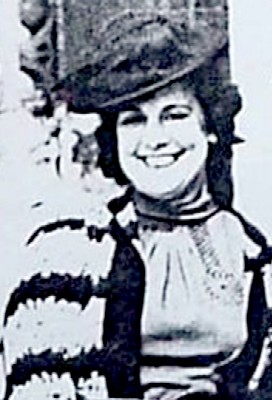
Jessie van Hallen
born in Wolstanton in Staffordshire, England to a family of engravers. She was encouraged by her parents to go to Burslem School of Art and also studied figure drawing for a few months at West Ham Polytechnic. She wanted to go to a London college of art to study for several years, but her father wouldn't let her. She had an aptitude for sculpting, so he helped her, taking her with him when he called on pottery makers (potbanks). In this way she got started doing freelance modeling for them. "Van Hallen was earning £5 ('a fortune in those days') for a model which might have taken her only a few hours. She worked for various potteries including Moorcroft and Coalport, and did an enormous amount of freelance work." (Jacquie Sarsby, Missuses and Mouldrunners: an oral history of women pottery-workers at work and at home, 1988, p. 52)
She married, likely in the late 1910s or early 1920s and had two children by 1930s. I found no mention of her husband's name or profession, although some websites suggest he was related to the Hallen family whose relatives had founded various earthenware pottery companies in Burslem. There is no indication of her husband's profession and the Hallen potters seem to have been out of business by the time she married him, with at least one of them being purchased by George Wade in 1907. Of her husband, Jessie later said he "has always been the sweetest man there is. Yes, he's lovely. And he just let me do my own thing." (Sarsby, p. 54)
It is likely through van Hallen's freelance work that she met George Wade. George Wade & Son, Limited manufactured industrial ceramics, but George decided to sell products in the lucrative giftware market, no doubt having seen the success of other companies. He asked Jessie to come work for him, setting up a small department for her. So she hired a nanny for her children and started with Wade, initially designing garden gnomes for Carter's Seeds. The modelers were typically men. Van Hallen noted, "...when I took things [to the modelers] they'd sort of say to me, 'Well, who's taught you to do all this? You're only a girl!' They didn't realize that I'd been at the college of art [for] so long, and I'd learned so much beforehand.'" (Sarsby, p. 55) Her appointment turned out to be important to the Wade company because her sculptures provided entry into the collectibles market.
"Jessie was allowed to set up her own small department at Wade's Manchester Pottery, reporting directly to George Wade himself. Here she produced her delicate floral arrangements, and now famous lady figurines.
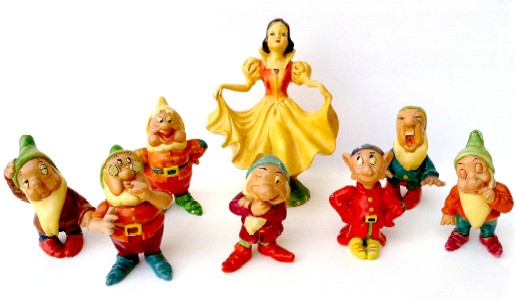
Jessie Van Hallen, Set of Snow White Figures, Porcelain and Cellulose, Wade and Sons, 1930s
With her great gift for modelling and his flair for marketing, they were a formidable pair. Eventually Jessie had studios in all three factories." ("George Albert Wade", The Potteries, gathered 5/20/24) Reflecting on her time with the company, Jessie said that she had having a very good relationship with the women who worked for her as casters and figure-makers.
Van Hallen's feminine figures had a distinct Art Deco design. Her first female figurine for Wade was thought to be Pavlova, which was followed by more than seventy figures from 1930 to 1940. Her designs are suggested to have been inspired by celebrities and film stars of the period. These were primarily made from with a cellulose finish, being aimed at the less expensive markets. Wade obtained the Disney license for Snow-White and the Seven Dwarfs, which van Hallen designed, the final pieces being produced by Wade Heath in their Royal Victoria Pottery line. "Her art deco pieces, such as 'Ginger', 'Lupino Lane' and 'Lotus' are collector's icons." (Fred Hughes, "A handful of history", BBC website, gathered 5/20/24) Note - it is not at all clear the figures to which Hughes is referring here. There was a Ginger Rogers statue (seen below right), but other than that, I found little evidence of the names he cites. Van Hallen's figures were typically released in a variety of different paint schemes. For this reason, they are often given a name and a number which appears to refer to the paint scheme.
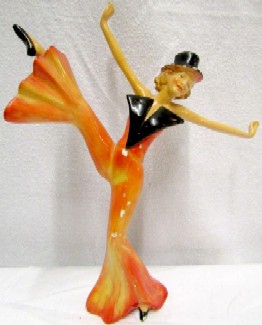
Jessie Van Hallen, Ginger Rogers, Porcelain
and Cellulose, Wade and Sons, 1930s
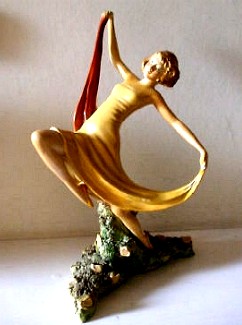
Jessie Van Hallen, Springtime, Porcelain
and Cellulose, Wade and Sons, 1930s
When World War II began, production of ceramic pieces like those created by Van Hallen ceased in order to produce things need for the war effort. "She wept when she received the letter giving her three months' notice, but she continued to work for various potteries and to freelance". A series of sculptures were sold by Dilford Pottery (established by a Mr S. Dillon) which included a small number of animal, bird and cottage models from moulds made by Jessie van Hallen. Based on information found on auction sites, they date from the 1950s. She continued to design pieces until at least 1981. "Sadly as with many other great artists, Jessie van Hallen only really achieved fame after her death in 1983 when collecting Wade was in its prime." (The Potteries website) The seven residence halls at Staffordshire University in Stoke are named after female ceramicists including one for Van Hallen.
Most of her Art Deco style sculptures from this period are of joyous women dancing, which is most fitting to the Jazz Age ideal. Likely because her statues were mass produced and sold to the average consumer, she isn't as well known among connoisseurs and a lot of her output seems to be sold on Ebay.
Other Sources Not Mentioned Above:
"Burslem School of Art Notable Students", City College website, gathered 5/20/24
"Dalton - Durham", British Pottery Histories website, gathered 5/20/24
"Dilford Studio Pottery Mow Cop Castle A Jessica Van Hallen Model", Worthpoint website, gathered 5/20/24
"Jessie van Hallen, Wikipedia website, gathered 5/20/24
Original Facebook Group Posting
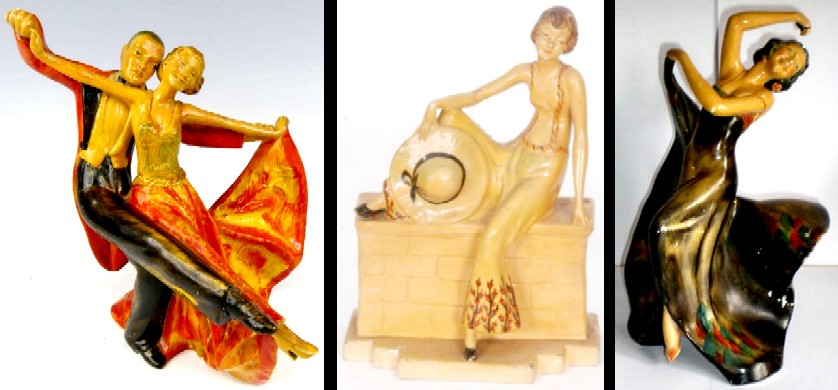 Jessi van Hallen Art Deco Sculptures, All are porcelain with a cellulose coating. (This is why they are so shiny.) From Left: Colorado 1, Lacy, Scott and Knight Antiques; Sadie 2, Fieldings Auctioneers; Carmen, Worthpoint. -
Jessi van Hallen Art Deco Sculptures, All are porcelain with a cellulose coating. (This is why they are so shiny.) From Left: Colorado 1, Lacy, Scott and Knight Antiques; Sadie 2, Fieldings Auctioneers; Carmen, Worthpoint. -